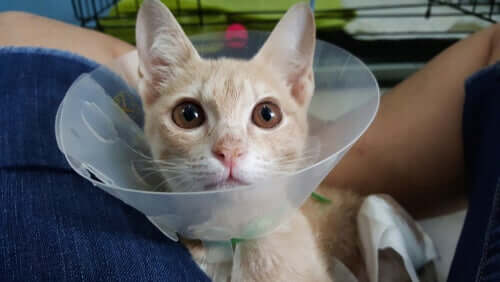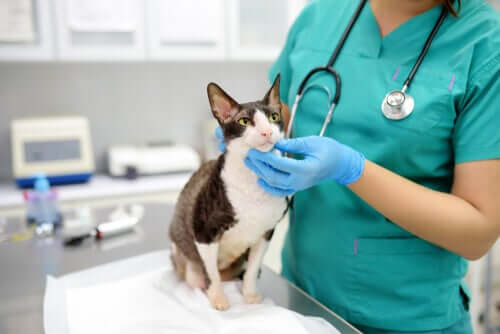Scabs on Cats: Symptoms and Treatment

Knowing for sure that your cat doesn’t suffer from any ailment is much more complicated than with other species. This is so because they know how to camouflage their emotions very well and almost never complain unless they’re really bothered by something. Scabs on cats are one of those things that you usually notice late if you don’t examine your pet regularly.
As they are wounds that appear on the skin, they go unnoticed under the fur at first, and even more so in long-haired cats. Only by touching them can we tell that something is wrong and can take appropriate action. However, the reasons why scabs appear on your cat’s skin can vary greatly.
Among the most common causes for this type of ailment are:
- Fighting with other animals
- Bacterial infections
- Mites
- Fungi
- Some type of allergy that leads to scratching more than usual
- Flea bites
Scabs in cats: Symptoms
Scabs are just a consequence of other factors. Most commonly, situations that have led to the cat itself hurting its skin when trying to remedy the discomfort. This extreme situation is achieved through the following actions:
- Excessive licking because of itching. As we all know, the cat has a particularly rough tongue. As a result, if the cat is feeling very itchy and they can reach the area with their tongue, it’ll be the animal’s first reaction. By licking themselves in excess, they end up losing hair and irritating their skin.
- Bites. Not only from other animals but from themselves. If the cat is bitten or the area is too itchy, they may bite themselves out of desperation and in the hope of ending such an annoying pain.

- Nervousness. As we often do when we have an itch, cats also get very nervous and moody when they have an itch that they can’t help. In addition, it clearly shows in their character that they’re feeling restless and irritable.
- Temporary loss of appetite. Scabs on cats can lead to a loss of the excitement they usually have for food. They even have such an impact on the animal’s character that they can lose their appetite completely!
- Diarrhea or vomiting. In cases where the animal is having a really bad time with the scabs, they may suffer from vomiting or diarrhea.
- Breathing problems from nasal scabs: One of the most worrying reasons for scabs in cats is cancer. If the cat has a tumor in his/her nose, they will get scabs.
Scabs on the head and neck
Scabs around the head and neck are common in cats. However, many people mistakenly believe that they come from rough play with other cats. This isn’t usually the case. The most likely cause is some type of allergy, the most common being flea allergy, food allergy, or allergy to something inhaled in the environment.
Treatment
Just as the reasons why scabs appear on cats are so diverse, so is the treatment. It’ll be necessary to carry out several of them to solve the issue. Of course, the first step is to take the cat to the vet for an exhaustive check-up and to diagnose the reason for the scab’s appearance.

Once the cause is identified, it’s crucial to start treatment as soon as possible. For instance, if the reason for the scabs appearing is fleas, everything will be solved with anti-parasites. If it comes from an infection, the corresponding medication will be given. In the case of a tumor, other measures would be taken, such as its removal or extirpation.
In any case, as usually happens with cats and other reserved animals, it’s best to be attentive to their behavior. Checking different areas of their body from time to time to verify that everything is going as it should is also recommended. In this way, both you and your beloved pet will enjoy a more pleasant and lasting coexistence.
https://misanimales.com/costras-gatos-sintomas-tratamientos/
All cited sources were thoroughly reviewed by our team to ensure their quality, reliability, currency, and validity. The bibliography of this article was considered reliable and of academic or scientific accuracy.
- Miwiki. Mi gato tiene costras, ¿qué le pasa? 7 de julio de 2019. Extraído de: https://www.miwuki.com/gato-costras-le-pasa
- Notigatos. Mi gato tiene costras, ¿qué le pasa? Extraído de: https://www.notigatos.es/mi-gato-tiene-costras/
- Experto animal. ¿Por qué mi gato tiene heridas en la piel? 10 de agosto de 2018. Extraído de: https://www.expertoanimal.com/por-que-mi-gato-tiene-heridas-en-la-piel-23618.html
- Marrero, L. G., & Fernández, Y. E. S. (2010). Caracterización y control de especies de pulgas de importancia veterinaria para la salud animal y pública. REDVET. Revista Electrónica de Veterinaria, 11(6), 1-18.
- Trillo, L. (2019). Guía para entender al gato. FAADA. Recuperado el 26 de marzo de 2022, disponible en: http://faada.org/docs/GuiaParaEntenderAlGato.pdf
This text is provided for informational purposes only and does not replace consultation with a professional. If in doubt, consult your specialist.